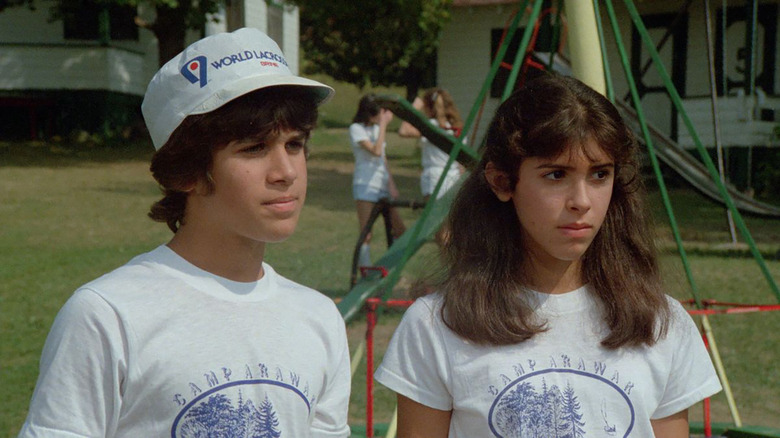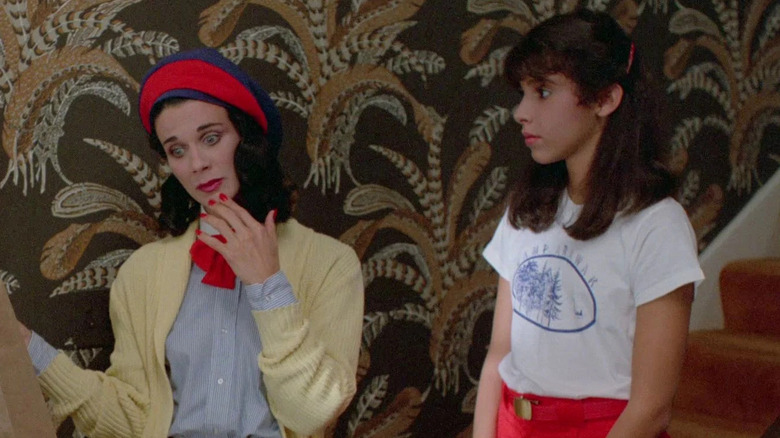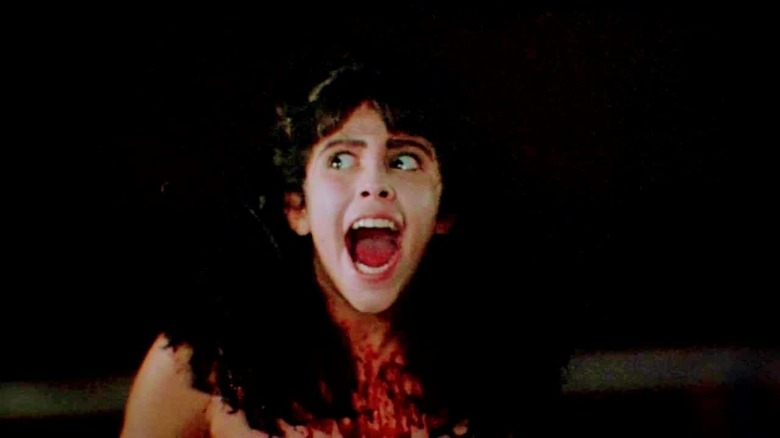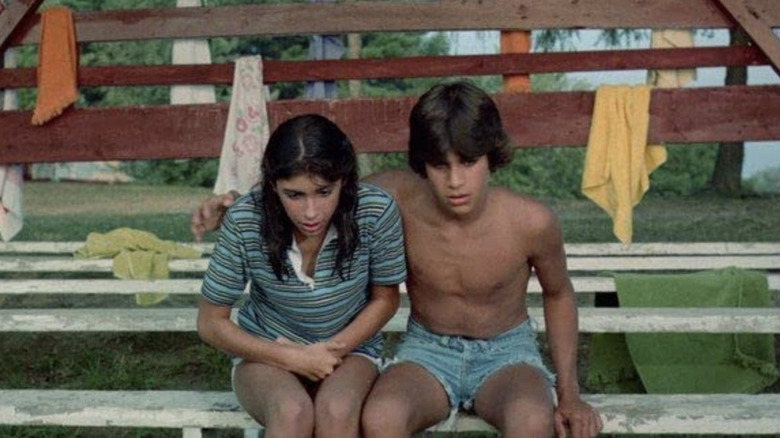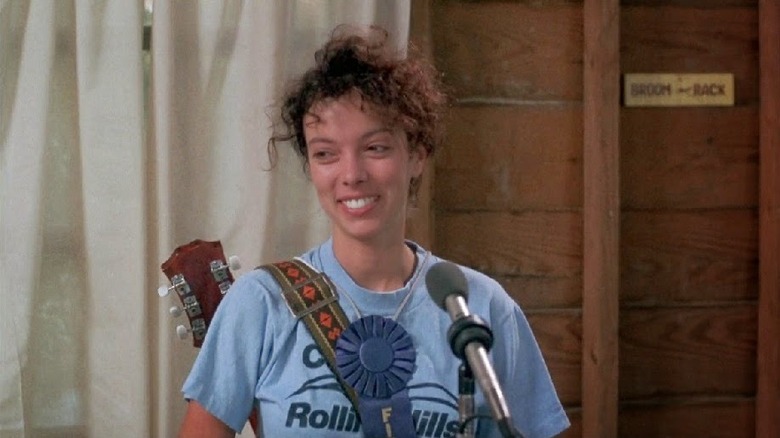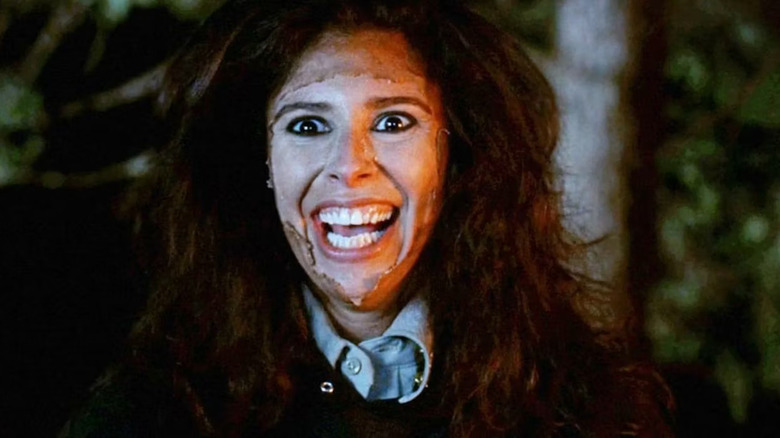Sleepaway Camp Ending Explained: At The Waterfront After The Social
The slasher boom of the 1980s was a wild time, where filmmakers were attempting to capitalize off of the popularity of films like John Carpenter's "Halloween" and Sean S. Cunningham's "Friday the 13th," while also trying not to appear like a cheap rip-off of either title. This led to success stories like the "Child's Play/Chucky" franchise, or colossal failures like "Boggy Creek II: And the Legend Continues." And then there are films like 1983's "Sleepaway Camp," a slasher film viewed as a classic by some and unforgivable schlock by others. There are five (you read that right) films in the series, but none have been able to capture the magic or reputation of the first one. Introducing scream queen Felissa Rose in her very first feature, "Sleepaway Camp" is a notorious bit of '80s camp (literal and metaphorical) known for casting actual teenagers to play the campers.
Diehard fans joke about the sheriff suddenly wearing a fake mustache in the final scene, the overabundance of men in denim cutoff shorts, incredible lines of dialogue like "eat s*** and live, Bill," and mean girl Judy's legendary side ponytail. But "Sleepaway Camp" is inarguably most remembered for the film's controversial ending, which is still debated over 40 years later.
An important note, I will be using she/her pronouns to refer to Angela unless otherwise noted. This is not an attempt to misgender the character but considering the film's complicated approach to gender identity and multiple interpretations of the ending, the decision is purely for readability.
What you need to remember about the plot of Sleepaway Camp
"Sleepaway Camp" doesn't open on the summer of Angela Baker's killing spree, but a few years earlier when she, her brother Peter, their father John, and his partner Lenny are out on the water for a family trip. Some meddling teens waterskiing accidentally go out of control on their boat and run over Peter and John, killing them instantly. A short while later, Angela is now living with her Aunt Martha and cousin Ricky and doesn't talk much. She and Ricky head off to Camp Arawak for the summer, where Ricky is a returning camper and Angela is the "weird" new girl. Immediately, Angela is targeted by mean counselor Meg, popular camper Judy, and many of the boys who are constantly bickering with Ricky as well.
Angela does find solace in Ricky's friend Paul, one of the only campers who shows her any kindness. But it isn't just the kids who are cruel to Angela. Aunt Martha doesn't actually care about Angela's autonomy, the camp cook is a predator, camp owner Mel is a greedy creep who doesn't care about the safety of children, and many of the counselors are too busy hooking up with each other to protect the bullied Angela.
When the bodies start to drop, Mel tries to keep the camp open by any means necessary, leading to what is considered by many to be one of the most "shocking" endings in slasher movie history.
What happened at the end of Sleepaway Camp?
On the final night of camp, the body count rises considerably. Meg is found stabbed to death in the communal shower after beating up Ricky (who she assumed was the killer), camp owner Mel takes an archery arrow through the throat, Judy is vaginally penetrated with a hot curling iron and suffocated, and a group of sleeping children are hacked to bits in their sleeping bags. Angela agrees to meet up with Paul at the waterfront after the social, keeping them away from the carnage across the camp's grounds. The counselors discover all of the bodies and try to wrangle together all of the campers to best keep track of them and keep them safe. When it's discovered that Angela and Paul are unaccounted for, counselors Ronnie and Susie go looking for the young lovebirds.
They eventually find them sitting on the shoreline, with Angela humming a song and sitting naked on the beach. Angela stands up and drops Paul's decapitated head, revealing that not only is she the killer, but that she is also "a boy" as evidenced by her displayed penis. Angela hisses like a wild animal, the camera freezes on her face, and the screen is washed in a green filter before the credits roll. The end of "Sleepaway Camp" is so memorable, that even people who've never seen the film know how it ends. It was even the subject of a "Robot Chicken" sketch from season 1 in 2005, where they reenact the ending as a character exclaims, "Oh my God! Somebody remembered this movie and wrote a comedy sketch about it!" The joke is a reference to camp counselor Ronnie exclaiming, "Oh my God, she's a boy!"
The surface-level interpretation of the ending of Sleepaway Camp
With the reveal that Angela is the killer and that she's actually "a boy" and not an innocent teen girl, "Sleepaway Camp" (depending on your interpretation) can fall under the "killer crossdresser" trope, of which Norman Bates in "Psycho," Bobbi Elliott from "Dressed to Kill," the Bride in the "Insidious" franchise, and even Leatherface in "The Texas Chainsaw Massacre: The Next Generation" all belong. The trope is harmful because by presenting the villain as a man pretending to be a woman, it implies that there is something morally wrong or dangerous about people perceived as "men in women's clothing," which can be applied by ignorant, fear-mongering jerks to trans women just trying to exist.
In fact, there are so many horror films that center on this "reveal" and yet crossdressing or being transgender are not considered deviant behaviors by the FBI. Despite this, the transphobic public at large, fueled by information gained from horror films (or sensationalist reports of figures like Ed Gein), takes fiction as gospel. As such, the ending is irresponsible at best and dangerous at worst.
In order to pull off the big reveal, a drunk, male college student stood nude while wearing a mask made to resemble actress Felissa Rose's face. The so-called "shocking" twist reveal implies that Peter/Angela became a killer as a result of forced crossdressing, which on the surface, does seem to support the transphobic "they walk amongst us" rhetoric. However, while intentional or not, the original "Sleepaway Camp" film actually has a far more nuanced and gender-affirming ending if one challenges themselves to look beyond the initial shock value, which in 2023, isn't all that shocking.
The better take on the ending of Sleepaway Camp
"Sleepaway Camp" is "bad" transgender representation, but its reveal inadvertently presents a fantastic message about how forcing gender roles onto someone that doesn't align with who they are is dangerous. Had Peter not been forced to live his life as "Angela," the events at Camp Arawak would not have happened, and that includes more than just the murders. The type of harassment Angela received all summer is rooted in misogyny — all things Peter would not have experienced had he been given permission to present as male. He also would have had Ronnie as his camp counselor, and not the cruel Meg. Not to mention, he wouldn't have years of psychological confusion, dysphoria, or emotional abuse as a result of his Aunt Martha's actions.
Gender dysphoria does not make murderers, but living in an affirming home with gender-affirming support saves lives, as children living in non-affirming homes experience depression, suicidal ideations, and sometimes violent outbursts at higher levels than their peers. It's not being trans (or in the case of Peter, not being trans) that causes these issues — it's having to live in a world that doesn't allow them to live authentically. The big "shock" of "Sleepaway Camp" is not what's between Angela's legs, it's the realization that a young boy has been abused and mentally tortured for years, and this killing spree is a result of the failure of every adult in his life.
Taking discussions of gender out of the equation altogether, this is a child who has been forced to take on the identity of his dead sibling, something that has undoubtedly done permanent emotional damage. And yet all of these aspects of Peter's psychology are completely ignored because people are too quick to fixate on something as arbitrary as whether or not the killer has a penis.
What the end of Sleepaway Camp meant for the franchise
There are five films in the "Sleepaway Camp" franchise, with Michael A. Simpson directing "Sleepaway Camp II: Unhappy Campers" and "Sleepaway Camp III: Teenage Wasteland," Jim Markovic directing "Sleepaway Camp IV: The Survivor," which features archive footage from the first three films, and Robert Hiltzik coming back for the fourth film, "Return to Sleepaway Camp." Canonically speaking, Hiltzik's film ignores the events of the other "Sleepaway Camp" films and serves as a direct sequel to the first film, but "Sleepaway Camp II, III, and IV" are direct sequels to the first film as well. This means there are two different canonical timelines coming off of the original.
In the first timeline, Angela is institutionalized but pursues gender-affirming surgery, living fully as a transgender woman but now played by Pamela Springsteen (yes, the sister of Bruce Springsteen). In Hiltzik's timeline, Angela adopts the identity of Sheriff Jerry, committing murders while disguised as a man but revealed to be Angela all grown up years later (and played once again by Felissa Rose). Both timelines represent different directions for Angela to take post-killing spree at Camp Arawak, but both end in the same way — death and destruction.
What has the director and star said about the ending of Sleepaway Camp?
"Sleepaway Camp" may be filled with plenty to analyze, but there's a big difference between a creator's intent vs. their impact. Filmmaker Robert Hiltzik did not intend to create such a brilliantly subversive film, and the twist ending reveal was inserted solely for shock value. "Well, you know, the way I wrote the film was I came up with a beginning and I came up with the end," Hiltzik said in a 2014 interview with Den of Geek. "I wanted a good beginning to grab the audience right away and then hold onto them, then I wanted a shocking ending or a twist that they would talk about when they walked out of the movie theater." Hiltzik chose the psychosexual angle first and then tried to sprinkle in clues throughout the film as a means of foreshadowing. "There had to be that issue — even if it's just below the surface it had to be presented," he said.
Given the now iconic status of the ending, rumors have circulated for decades that this ending was tacked on for additional shock value and that an alternate ending exists somewhere on some forgotten reel of film. However, star Felissa Rose confirmed in 2000 that the ending of "Sleepaway Camp" was the only ending the film ever had, and the only ending that was shot. As she noted in an interview at the time with "Sleepaway Camp" historian Jeff Hayes, "There was absolutely no other ending than the one you saw in the film. In the original script that's just exactly the way it played out! That's it. There was nothing else. That's exactly the way Robert Hiltzik intended."
So regardless of how anyone feels about this ending, it's the one that was always going to be a part of the film — for better, or worse.
